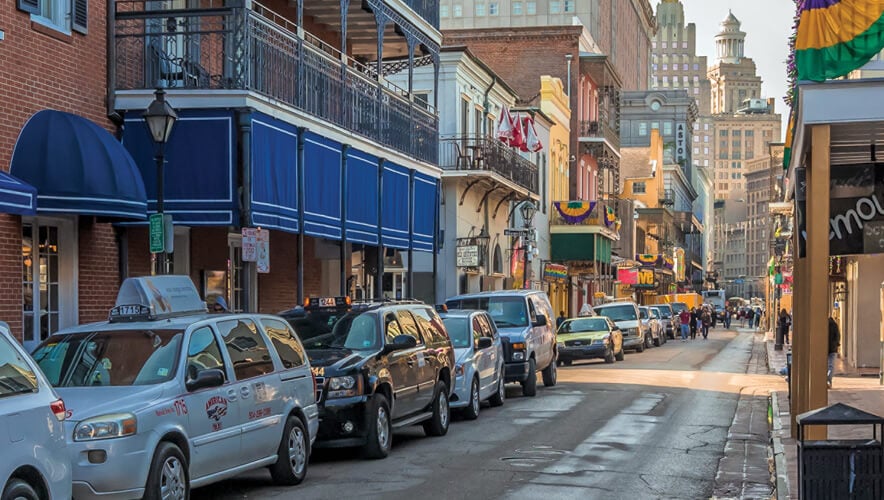The Road to Resilience
Of course, 100RC had neither the resources nor staff to partner with 10,000 cities. But organization leaders argued that its 100 member cities could be models for institutionalizing resilience—that is, embedding resilience thinking into all the decisions city leaders make on a day-to-day basis, so that resilience is mainstreamed into the city government's policies and practices. Other cities could then adapt the model to fit their own parameters, and institutionalized resilience would spread throughout the world.
Toward this aim, 100RC recently released a report that discusses three case studies of institutionalizing resilience in New Orleans, Louisiana; Melbourne, Australia; and Semarang, Indonesia.
For all cities that 100RC works with, the organization provides funding to hire a new executive, the chief resilience officer (CRO). The group also advocates that member cities take the "10% Resilience Pledge," under which 10 percent of the city's annual budget goes toward resilience-building goals and projects. So far, nearly 30 member cities have taken the pledge, which has focused more than $5 billion toward resilience projects.
Of the three case study cities, New Orleans may be most known as a jurisdiction that has had to recover from repeated recent disasters, including Hurricanes Katrina and Isaac and the Deepwater Horizon oil spill. Given these experiences, New Orleans was one of the first cities to release a holistic resilience strategy, which connected resilience practices to almost all sectors of the city, including equity, energy, education, and emergency planning.
The strategy, Resilient New Orleans, has three underlying goals: strengthen the city's infrastructure, embrace the changing environment instead of resisting it, and create equal opportunities for all residents.
To better implement the strategy, New Orleans CRO Jeff Hebert was promoted to the level of first deputy mayor, and departments were joined to unite resilience planning with key sectors like water management, energy, transportation, coastal protection, and climate change.
Once this reconfiguration was complete, the city took several actions. It created the Gentilly Resilience District, which is aimed at reducing flood risk, slowing land subsidence, and encouraging neighborhood revitalization. The resilience district combines various approaches to water and land management to move forward on projects that will make the area more resilient. The city will also train some underemployed residents to work on the projects.
In addition, New Orleans leaders are developing and implementing new resilience design standards for public works and infrastructure, so that efforts to improve management of storm water and multi-modal transit systems will be included as standard design components.
Melbourne has its own challenges. Situated on the boundary of a hot inland area and a cool Southern Ocean, it can be subject to severe weather, such as gales, thunderstorms and hail, and large temperature drops. Governmentally, it is a "city of cities" made up of 32 local councils from around the region, so critical issues such as transportation, energy, and water systems are managed by various bodies, complicating decision making.
City leaders created the Resilient Melbourne Delivery Office, which will be hosted by the City of Melbourne for five years, jointly funded by both local and state governments. The office—an interdisciplinary team of at least 12 people, led by the CRO Toby Kent—is responsible for overseeing the delivery of the resilience strategy.
The strategy has four main goals: empower communities to take active responsibility for their own well-being; create sustainable infrastructure that will also promote social cohesion; provide diverse local employment opportunities to support an adaptable workforce; and ensure support for strong natural assets.
For Semarang, a coastal city in an archipelago, water is the main focus of sustainability. Factors like a rise in sea levels and coastal erosion have increased the negative impact of floods.
These impacts can challenge the city in many ways. Thus, for its resilience strategy, Semarang leaders focused on building capacities, including more economic opportunity, disaster risk management, integrated mobility, and sustainable water strategies.
In Indonesia, like many other Asian countries, the national government sets the goals and parameters for much of the development that takes place at the local level. Thus, Semarang leaders worked with members of the Indonesian Parliament to educate them on the city's existing resilience strategy, and to integrate the city's findings and insights into Indonesia's National Development Plan.
These coordination efforts bore fruit in the establishment of projects like a bus rapid transit system, which had strong support from the national government. The system has already been implemented in several main corridors and will be expanded. It is expected to offer insight and experience in cross-boundary resilience-related travel.
As 100RC cities look to institutionalize resiliency, the organization is also helping members improve their emergency management programs. The group is partnering with the Intermedix Corporation, which will help some member cities assess their current emergency management programs, and develop a blueprint for addressing gaps in the program and meeting resiliency goals.
"As new and complex problems and challenges arise, it's becoming more and more important for cities to look outside of their own organizations for the expertise and solutions required to meet and overcome these challenges," says Michael Berkowitz, president of 100RC.
